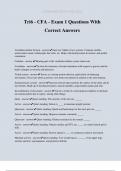©THEBRIGHTSTARS 2024
Tri6 - CFA - Exam 1 Questions With
Correct Answers
Vestibulocochlear System - answer✔Inner ear. Made of two systems. Contains otoliths,
semicircular canals, endolymph, hair cells, etc. Helps with head position & motion, and spatial
orientation.
Cochlear - answer✔Hearing part of the vestibulocochlear system (inner ear)
Vestibular - answer✔System for awareness of head orientation with respect to gravity and the
head's changes in velocity and direction.
Visual system - answer✔Serves as a strong motion detector, particularly in balancing
movements. Gives info about a person's own body movements in relation to the environment.
Somatosensory system - answer✔Sensory network that monitors the surface of the body and its
movements. Made up of mechanoreceptors, muscle spindles, golgi tendon organs,and skin.
Incoordination of movement - answer✔Can be a result of a neurological condition or aberrant
movement pattern due to injury, among other things.
Quiet - answer✔Quiet standing: The muscles of the feet are ______
Active - answer✔Quiet standing: Soleus is ____ to maintain upright posture.
Quiescent - answer✔Quiet standing: Quads and hamstrings for the most part are _____
Active - answer✔Quiet standing: Iliopsoas remains constantly _____.
Quiescent - answer✔Quiet standing: Gluteus maximus & abs remain _____.
Active - answer✔Quiet standing: Gluteus medius and TFL are _____ to control lateral pelvic
shift.
Active - answer✔Quiet standing: Erector spinae is ____ to counteract anterior movement.
Minimal activity - answer✔Quiet standing: You would expect _______ from upper trap,
serratus anterior, supraspinatus, and posterior deltoid.
, ©THEBRIGHTSTARS 2024
Lateral head tilt - answer✔This presentation indicates ________.
Tight: Scalene, SCM, upper traps, levator scap. (Same side)
Weak: Scalene, SCM, upper traps, levator scap. (Opp. Side)
Head rotation - answer✔This presentation indicates ________.
Tight: SCM, upper traps, levator scap, scalene, intrinsic rotator
Weak: Opposite rotator
Elevated shoulder - answer✔This presentation indicates ________.
Tight: Upper trap, levator scap
Weak: Lower trap, rhomboids, pec minor, lat dorsi
Rounded shoulders - answer✔This presentation indicates ________.
Tight: Subscap, teres major, anterior deltoid, lat dorsi, pec major/minor
Weak: Infraspinatis, teres minor, rhomboids, mid/lower traps, posterior deltoid
Winging scapula - answer✔This presentation indicates ________.
Tight: Pec minor
Weak: Serratus anterior, lower trap
Winged scapula - answer✔Medial border of the scapula lifts off ribs. Can be caused by muscle
imbalance, impaired long thoracic nerve, or impaired CN XI.
Elevated scapula - answer✔This presentation indicates ________.
Tight:Upper traps, levator scapula, pic minor
Weak: Mid/lower traps, rhomboids
Lateral pelvic tilt - answer✔One side of the pelvis is higher than the other. Can observe a leg
length discrepancy, lumbar/SI pathology, scoliosis.
Lateral pelvic tilt - answer✔This presentation indicates ________.
Tight: QL (high side), hip abductor (low side), hip adductor (high)
Weak: Abductors (high), adductors (low), QL (low)
Lumbar pathology - answer✔Common cause of a lateral pelvic shift
Lateral pelvic shift - answer✔This presentation indicates ________.




